Wei Luo
TED++: Submanifold-Aware Backdoor Detection via Layerwise Tubular-Neighbourhood Screening
Oct 16, 2025Abstract:As deep neural networks power increasingly critical applications, stealthy backdoor attacks, where poisoned training inputs trigger malicious model behaviour while appearing benign, pose a severe security risk. Many existing defences are vulnerable when attackers exploit subtle distance-based anomalies or when clean examples are scarce. To meet this challenge, we introduce TED++, a submanifold-aware framework that effectively detects subtle backdoors that evade existing defences. TED++ begins by constructing a tubular neighbourhood around each class's hidden-feature manifold, estimating its local ``thickness'' from a handful of clean activations. It then applies Locally Adaptive Ranking (LAR) to detect any activation that drifts outside the admissible tube. By aggregating these LAR-adjusted ranks across all layers, TED++ captures how faithfully an input remains on the evolving class submanifolds. Based on such characteristic ``tube-constrained'' behaviour, TED++ flags inputs whose LAR-based ranking sequences deviate significantly. Extensive experiments are conducted on benchmark datasets and tasks, demonstrating that TED++ achieves state-of-the-art detection performance under both adaptive-attack and limited-data scenarios. Remarkably, even with only five held-out examples per class, TED++ still delivers near-perfect detection, achieving gains of up to 14\% in AUROC over the next-best method. The code is publicly available at https://github.com/namle-w/TEDpp.
Automated Detection of Pre-training Text in Black-box LLMs
Jun 24, 2025Abstract:Detecting whether a given text is a member of the pre-training data of Large Language Models (LLMs) is crucial for ensuring data privacy and copyright protection. Most existing methods rely on the LLM's hidden information (e.g., model parameters or token probabilities), making them ineffective in the black-box setting, where only input and output texts are accessible. Although some methods have been proposed for the black-box setting, they rely on massive manual efforts such as designing complicated questions or instructions. To address these issues, we propose VeilProbe, the first framework for automatically detecting LLMs' pre-training texts in a black-box setting without human intervention. VeilProbe utilizes a sequence-to-sequence mapping model to infer the latent mapping feature between the input text and the corresponding output suffix generated by the LLM. Then it performs the key token perturbations to obtain more distinguishable membership features. Additionally, considering real-world scenarios where the ground-truth training text samples are limited, a prototype-based membership classifier is introduced to alleviate the overfitting issue. Extensive evaluations on three widely used datasets demonstrate that our framework is effective and superior in the black-box setting.
TED-LaST: Towards Robust Backdoor Defense Against Adaptive Attacks
Jun 12, 2025Abstract:Deep Neural Networks (DNNs) are vulnerable to backdoor attacks, where attackers implant hidden triggers during training to maliciously control model behavior. Topological Evolution Dynamics (TED) has recently emerged as a powerful tool for detecting backdoor attacks in DNNs. However, TED can be vulnerable to backdoor attacks that adaptively distort topological representation distributions across network layers. To address this limitation, we propose TED-LaST (Topological Evolution Dynamics against Laundry, Slow release, and Target mapping attack strategies), a novel defense strategy that enhances TED's robustness against adaptive attacks. TED-LaST introduces two key innovations: label-supervised dynamics tracking and adaptive layer emphasis. These enhancements enable the identification of stealthy threats that evade traditional TED-based defenses, even in cases of inseparability in topological space and subtle topological perturbations. We review and classify data poisoning tricks in state-of-the-art adaptive attacks and propose enhanced adaptive attack with target mapping, which can dynamically shift malicious tasks and fully leverage the stealthiness that adaptive attacks possess. Our comprehensive experiments on multiple datasets (CIFAR-10, GTSRB, and ImageNet100) and model architectures (ResNet20, ResNet101) show that TED-LaST effectively counteracts sophisticated backdoors like Adap-Blend, Adapt-Patch, and the proposed enhanced adaptive attack. TED-LaST sets a new benchmark for robust backdoor detection, substantially enhancing DNN security against evolving threats.
When Better Features Mean Greater Risks: The Performance-Privacy Trade-Off in Contrastive Learning
Jun 06, 2025Abstract:With the rapid advancement of deep learning technology, pre-trained encoder models have demonstrated exceptional feature extraction capabilities, playing a pivotal role in the research and application of deep learning. However, their widespread use has raised significant concerns about the risk of training data privacy leakage. This paper systematically investigates the privacy threats posed by membership inference attacks (MIAs) targeting encoder models, focusing on contrastive learning frameworks. Through experimental analysis, we reveal the significant impact of model architecture complexity on membership privacy leakage: As more advanced encoder frameworks improve feature-extraction performance, they simultaneously exacerbate privacy-leakage risks. Furthermore, this paper proposes a novel membership inference attack method based on the p-norm of feature vectors, termed the Embedding Lp-Norm Likelihood Attack (LpLA). This method infers membership status, by leveraging the statistical distribution characteristics of the p-norm of feature vectors. Experimental results across multiple datasets and model architectures demonstrate that LpLA outperforms existing methods in attack performance and robustness, particularly under limited attack knowledge and query volumes. This study not only uncovers the potential risks of privacy leakage in contrastive learning frameworks, but also provides a practical basis for privacy protection research in encoder models. We hope that this work will draw greater attention to the privacy risks associated with self-supervised learning models and shed light on the importance of a balance between model utility and training data privacy. Our code is publicly available at: https://github.com/SeroneySun/LpLA_code.
Test-Time Learning for Large Language Models
May 27, 2025

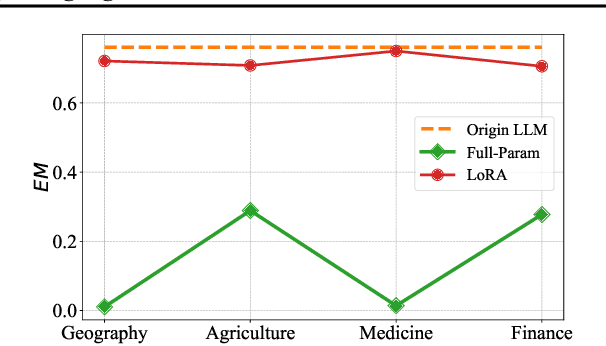
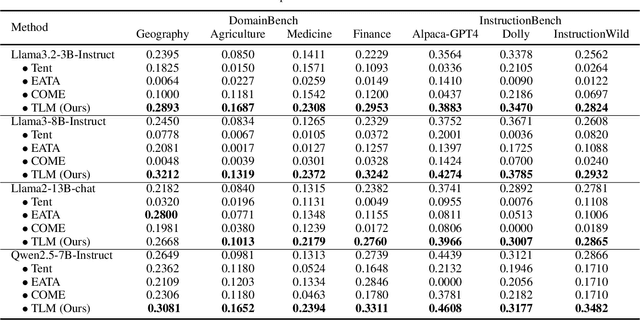
Abstract:While Large Language Models (LLMs) have exhibited remarkable emergent capabilities through extensive pre-training, they still face critical limitations in generalizing to specialized domains and handling diverse linguistic variations, known as distribution shifts. In this paper, we propose a Test-Time Learning (TTL) paradigm for LLMs, namely TLM, which dynamically adapts LLMs to target domains using only unlabeled test data during testing. Specifically, we first provide empirical evidence and theoretical insights to reveal that more accurate predictions from LLMs can be achieved by minimizing the input perplexity of the unlabeled test data. Based on this insight, we formulate the Test-Time Learning process of LLMs as input perplexity minimization, enabling self-supervised enhancement of LLM performance. Furthermore, we observe that high-perplexity samples tend to be more informative for model optimization. Accordingly, we introduce a Sample Efficient Learning Strategy that actively selects and emphasizes these high-perplexity samples for test-time updates. Lastly, to mitigate catastrophic forgetting and ensure adaptation stability, we adopt Low-Rank Adaptation (LoRA) instead of full-parameter optimization, which allows lightweight model updates while preserving more original knowledge from the model. We introduce the AdaptEval benchmark for TTL and demonstrate through experiments that TLM improves performance by at least 20% compared to original LLMs on domain knowledge adaptation.
Center-aware Residual Anomaly Synthesis for Multi-class Industrial Anomaly Detection
May 23, 2025Abstract:Anomaly detection plays a vital role in the inspection of industrial images. Most existing methods require separate models for each category, resulting in multiplied deployment costs. This highlights the challenge of developing a unified model for multi-class anomaly detection. However, the significant increase in inter-class interference leads to severe missed detections. Furthermore, the intra-class overlap between normal and abnormal samples, particularly in synthesis-based methods, cannot be ignored and may lead to over-detection. To tackle these issues, we propose a novel Center-aware Residual Anomaly Synthesis (CRAS) method for multi-class anomaly detection. CRAS leverages center-aware residual learning to couple samples from different categories into a unified center, mitigating the effects of inter-class interference. To further reduce intra-class overlap, CRAS introduces distance-guided anomaly synthesis that adaptively adjusts noise variance based on normal data distribution. Experimental results on diverse datasets and real-world industrial applications demonstrate the superior detection accuracy and competitive inference speed of CRAS. The source code and the newly constructed dataset are publicly available at https://github.com/cqylunlun/CRAS.
NTIRE 2025 challenge on Text to Image Generation Model Quality Assessment
May 22, 2025Abstract:This paper reports on the NTIRE 2025 challenge on Text to Image (T2I) generation model quality assessment, which will be held in conjunction with the New Trends in Image Restoration and Enhancement Workshop (NTIRE) at CVPR 2025. The aim of this challenge is to address the fine-grained quality assessment of text-to-image generation models. This challenge evaluates text-to-image models from two aspects: image-text alignment and image structural distortion detection, and is divided into the alignment track and the structural track. The alignment track uses the EvalMuse-40K, which contains around 40K AI-Generated Images (AIGIs) generated by 20 popular generative models. The alignment track has a total of 371 registered participants. A total of 1,883 submissions are received in the development phase, and 507 submissions are received in the test phase. Finally, 12 participating teams submitted their models and fact sheets. The structure track uses the EvalMuse-Structure, which contains 10,000 AI-Generated Images (AIGIs) with corresponding structural distortion mask. A total of 211 participants have registered in the structure track. A total of 1155 submissions are received in the development phase, and 487 submissions are received in the test phase. Finally, 8 participating teams submitted their models and fact sheets. Almost all methods have achieved better results than baseline methods, and the winning methods in both tracks have demonstrated superior prediction performance on T2I model quality assessment.
Secure Transfer Learning: Training Clean Models Against Backdoor in (Both) Pre-trained Encoders and Downstream Datasets
Apr 16, 2025Abstract:Transfer learning from pre-trained encoders has become essential in modern machine learning, enabling efficient model adaptation across diverse tasks. However, this combination of pre-training and downstream adaptation creates an expanded attack surface, exposing models to sophisticated backdoor embeddings at both the encoder and dataset levels--an area often overlooked in prior research. Additionally, the limited computational resources typically available to users of pre-trained encoders constrain the effectiveness of generic backdoor defenses compared to end-to-end training from scratch. In this work, we investigate how to mitigate potential backdoor risks in resource-constrained transfer learning scenarios. Specifically, we conduct an exhaustive analysis of existing defense strategies, revealing that many follow a reactive workflow based on assumptions that do not scale to unknown threats, novel attack types, or different training paradigms. In response, we introduce a proactive mindset focused on identifying clean elements and propose the Trusted Core (T-Core) Bootstrapping framework, which emphasizes the importance of pinpointing trustworthy data and neurons to enhance model security. Our empirical evaluations demonstrate the effectiveness and superiority of T-Core, specifically assessing 5 encoder poisoning attacks, 7 dataset poisoning attacks, and 14 baseline defenses across five benchmark datasets, addressing four scenarios of 3 potential backdoor threats.
An Integrated AI-Enabled System Using One Class Twin Cross Learning (OCT-X) for Early Gastric Cancer Detection
Mar 31, 2025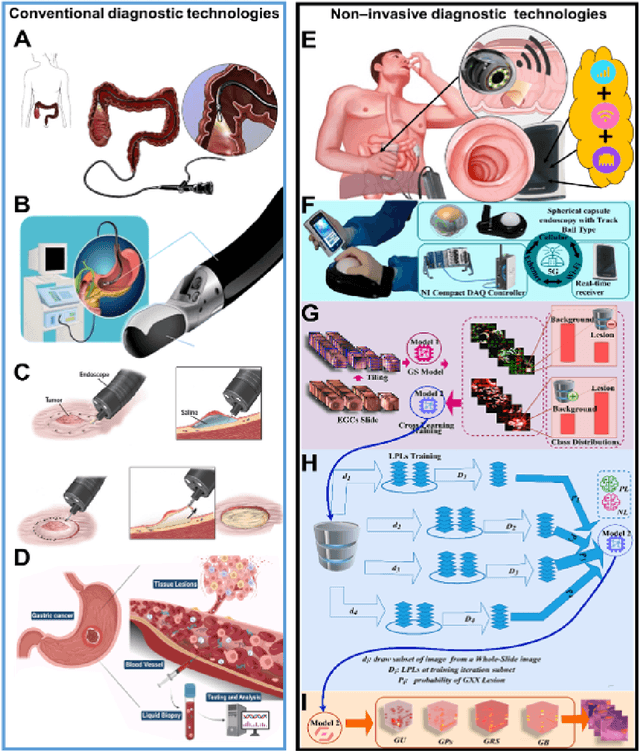
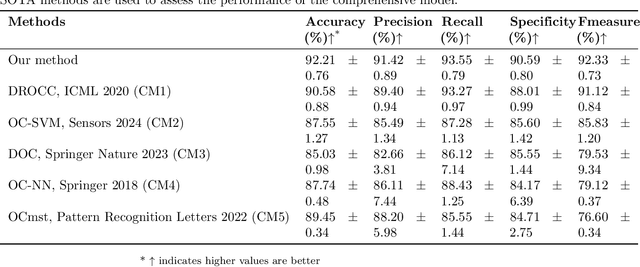
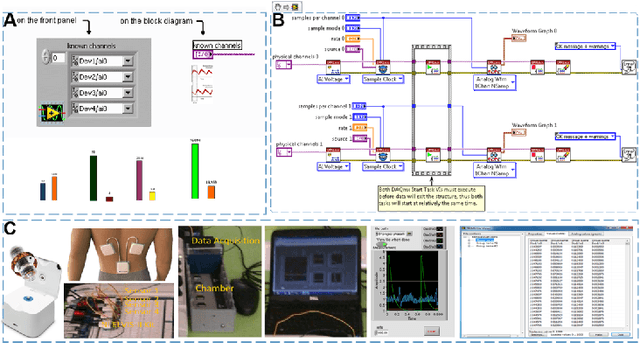
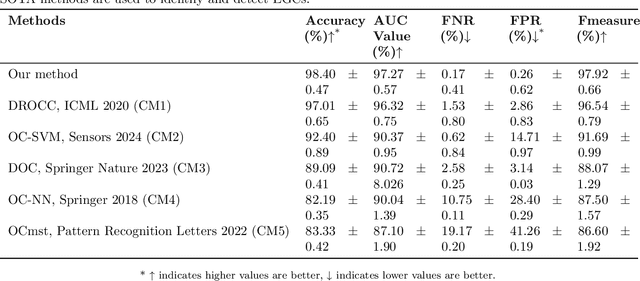
Abstract:Early detection of gastric cancer, a leading cause of cancer-related mortality worldwide, remains hampered by the limitations of current diagnostic technologies, leading to high rates of misdiagnosis and missed diagnoses. To address these challenges, we propose an integrated system that synergizes advanced hardware and software technologies to balance speed-accuracy. Our study introduces the One Class Twin Cross Learning (OCT-X) algorithm. Leveraging a novel fast double-threshold grid search strategy (FDT-GS) and a patch-based deep fully convolutional network, OCT-X maximizes diagnostic accuracy through real-time data processing and seamless lesion surveillance. The hardware component includes an all-in-one point-of-care testing (POCT) device with high-resolution imaging sensors, real-time data processing, and wireless connectivity, facilitated by the NI CompactDAQ and LabVIEW software. Our integrated system achieved an unprecedented diagnostic accuracy of 99.70%, significantly outperforming existing models by up to 4.47%, and demonstrated a 10% improvement in multirate adaptability. These findings underscore the potential of OCT-X as well as the integrated system in clinical diagnostics, offering a path toward more accurate, efficient, and less invasive early gastric cancer detection. Future research will explore broader applications, further advancing oncological diagnostics. Code is available at https://github.com/liu37972/Multirate-Location-on-OCT-X-Learning.git.
MindEye-OmniAssist: A Gaze-Driven LLM-Enhanced Assistive Robot System for Implicit Intention Recognition and Task Execution
Mar 17, 2025Abstract:A promising effective human-robot interaction in assistive robotic systems is gaze-based control. However, current gaze-based assistive systems mainly help users with basic grasping actions, offering limited support. Moreover, the restricted intent recognition capability constrains the assistive system's ability to provide diverse assistance functions. In this paper, we propose an open implicit intention recognition framework powered by Large Language Model (LLM) and Vision Foundation Model (VFM), which can process gaze input and recognize user intents that are not confined to predefined or specific scenarios. Furthermore, we implement a gaze-driven LLM-enhanced assistive robot system (MindEye-OmniAssist) that recognizes user's intentions through gaze and assists in completing task. To achieve this, the system utilizes open vocabulary object detector, intention recognition network and LLM to infer their full intentions. By integrating eye movement feedback and LLM, it generates action sequences to assist the user in completing tasks. Real-world experiments have been conducted for assistive tasks, and the system achieved an overall success rate of 41/55 across various undefined tasks. Preliminary results show that the proposed method holds the potential to provide a more user-friendly human-computer interaction interface and significantly enhance the versatility and effectiveness of assistive systems by supporting more complex and diverse task.
 Add to Chrome
Add to Chrome Add to Firefox
Add to Firefox Add to Edge
Add to Edge